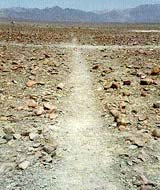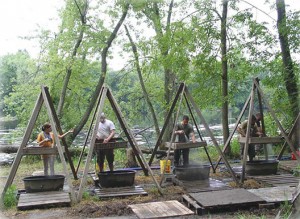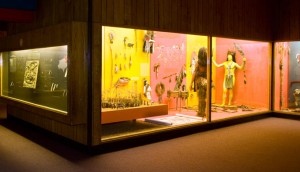Flying over the Nazca Desert in Southern Peru, lines, geometric patterns, and plants and animals can be seen engraved into the landscape. These lines were created by the Nazca people who were native to the area and thrived from 1-700 CE, predating the Incas by about 500 years. There have been theories over the past century regarding the line’s purpose and function, the most popular being that the lines were used by ancient aliens as landing strips for their spacecraft. A lot of the attention drawn to the Nazca lines stems from tales of intergalactic travel and the perpetuation of the enchantment and mystery attached to these figures. The allure of uncertainty sparks curiosity, but in the search for answers, unguided curiosity can lead to farfetched and sometimes damaging assumptions. Archaeology seeks to answer how and why people lived the way they did, proper study of artifacts, features, and sites such as the Nazca Lines can help us tell a more accurate story.

Nazca lines in the shape of a spider
In attempts to understand the how the Nazca Lines were used and what they meant for the Nazca culture several archaeological techniques can and were used on the site. For some of the more recent investigations, maps of the surrounding hills and valleys were created from the air. Doing so probably required methods of air reconnaissance such as aerial photography which later would be used with GIS to interpret the landscape. One of the early theories of the lines was studied using similar methods. Paul Kosok, a Geologist, had suggested that the geoglyphs hold astronomical significance aligning with celestial bodies, he even referred to them as “the largest astronomy book in the world.” However, Gerald Hawkins in 1968, using maps and astronomical data had disproved this idea; the figures and lines had appeared to be randomly placed with respect to sky.
Simple investigation such as surveying the landscape and understanding Nazca culture sheds light on common misconceptions. Popular media has lead most of us to believe that the geoglyphs could only be created through complex methods and that completing these works of art would not be possible without a vantage point well above the ground or alien intervention. However, it has been determined that the lines were created just by removing the top layer of soil, the soil in the Nazca desert has been oxidized and appears red, removing the top layer reveals a lighter color. Also, creation of the lines is not complex as some think, archaeologists have determined that with surveying equipment, they are easily replicable. As for the the vantage point issue, many of the images can be seen in their entirety from surrounding foothills. Just as with the burial mounds in the United States, the assumption that the people who inhabited the land were not capable of such creations or that Alien intervention was needed has roots in racism and stunts our ability to think critically about the site and culture. True archaeology helps discard these ideas and find the true story.

View of the lines up close.
References:
http://archaeologyonline.net/artifacts/nazca-lines
http://science.nationalgeographic.com/science/archaeology/nasca-lines/
http://www.skepdic.com/nazca.html
Photo1: http://en.wikipedia.org/wiki/Nazca_Lines#mediaviewer/File:Nazca-lineas-arana-c01.jpg
Photo2:http://archaeologyonline.net/artifacts/nazca-lines
For more about the site and Nazca culture:






